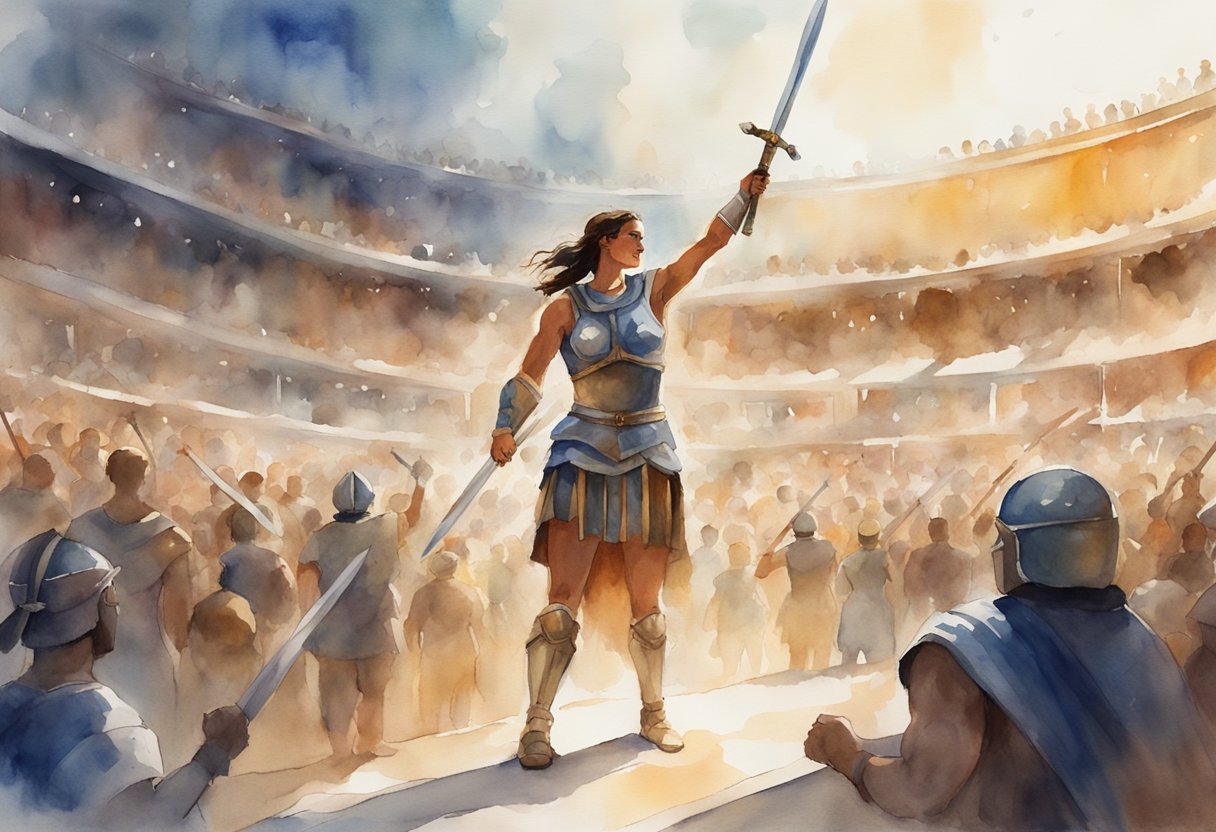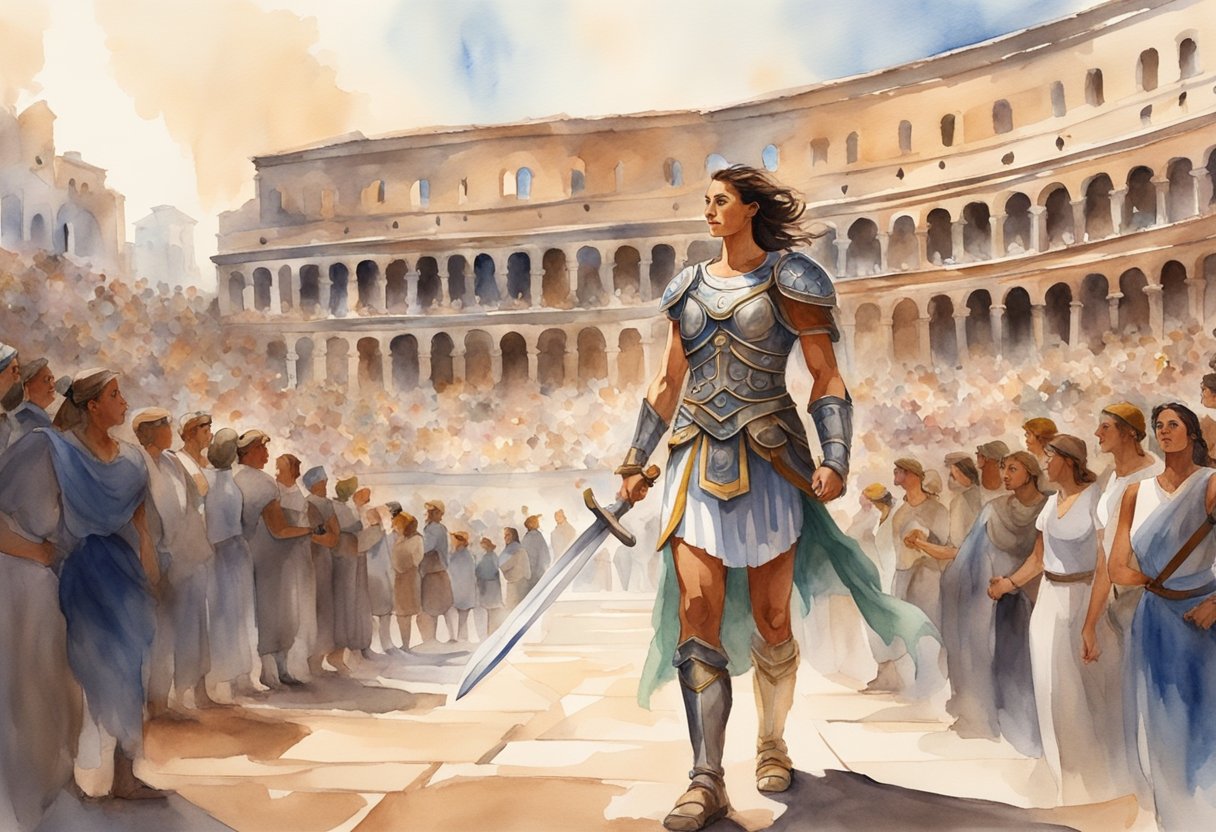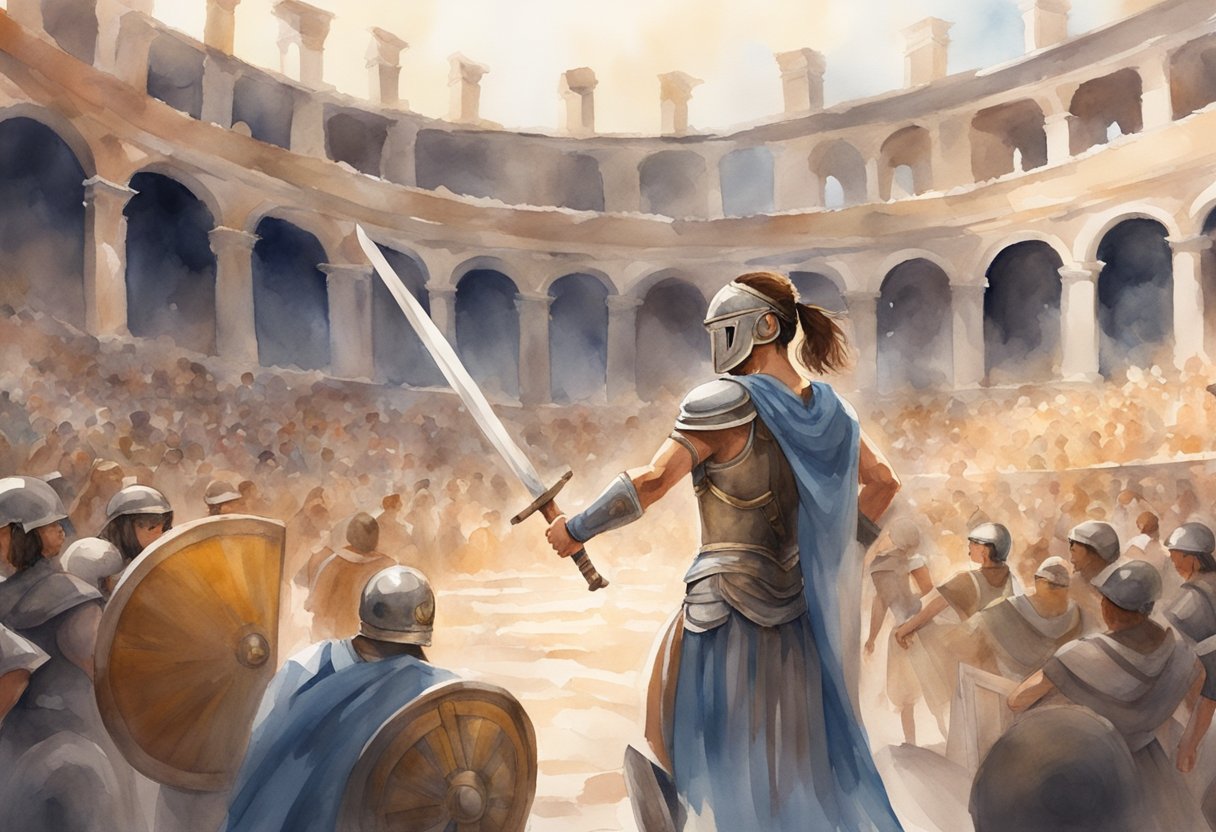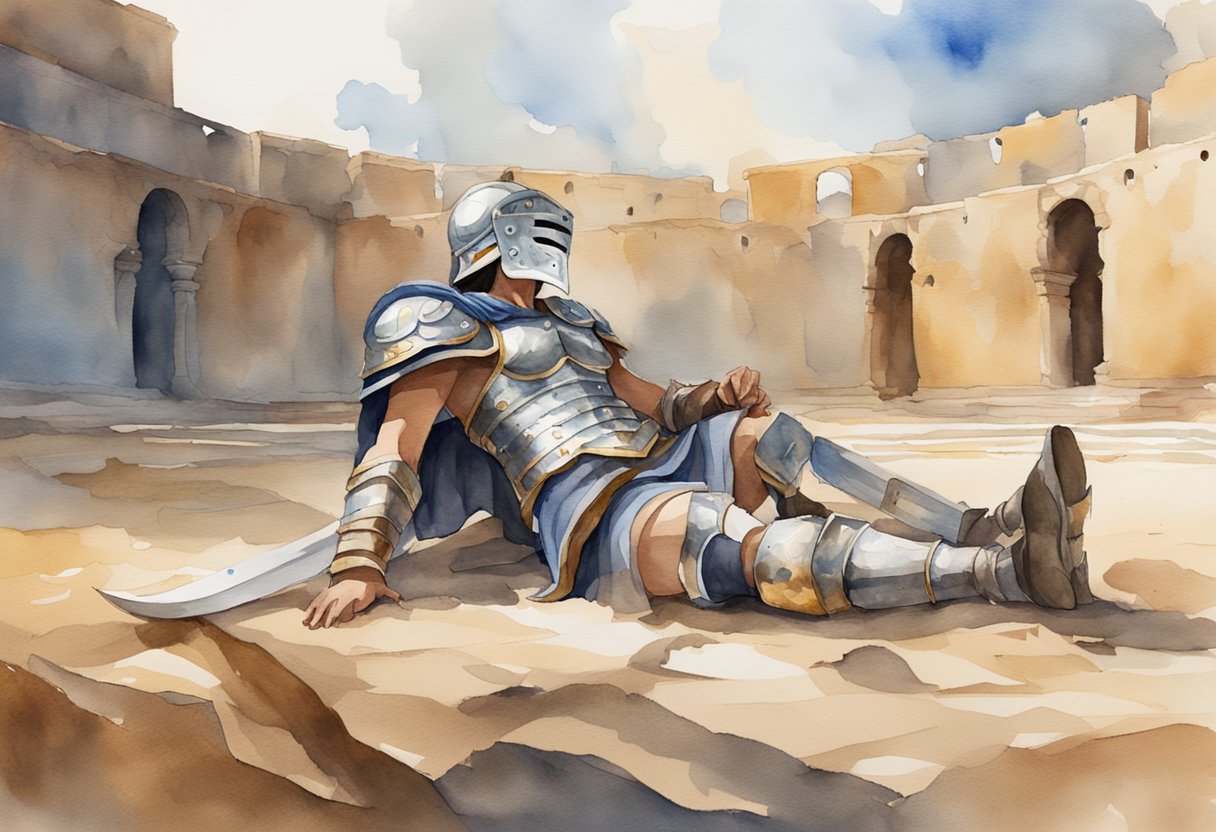In the grand and often brutal history of ancient Rome, the concept of gladiators is well-known. They are usually envisioned as burly men fighting for their lives and the entertainment of the masses. However, a lesser-known aspect of these ancient games is the existence of female gladiators.
These women, known as gladiatrices, occasionally graced the amphitheaters, taking up arms in contests that both mirrored and defied the traditional roles of women in Roman society.

While the idea of the female gladiator may seem novel or even fictional to modern sensibilities, historical evidence, including writings and artifacts, confirms their reality. These female combatants participated in bouts that enthralled audiences, showcasing not only physical strength but challenging gender norms of the era. Despite their participation in such high-profile events, the lives and societal impact of female gladiators are not as thoroughly documented as their male counterparts, leaving much of their history shrouded in mystery.
Key Takeaways
- Female gladiators were a real yet underdocumented facet of ancient Roman entertainment.
- These women, known as gladiatrices, competed in the amphitheaters and contributed to the complexity of Roman society.
- The existence of female gladiators challenges modern perceptions of gender roles in ancient times.
Historical Context
The female gladiator represents a unique and often understated facet of Roman history, intertwining the valor of combat with the complex dynamics of gender and social structure within the Roman Empire.
Rome’s Gladiatorial Origins
Gladiatorial games, spectacles of blood and valor, trace back to Rome’s early Republic era. Initially, these games were intended as funeral rites. However, they later evolved into a form of mass entertainment, reflective of Roman values and social order. The games were later popularized under the Empire.
Women in Roman Society
In Roman society, women — referred to as feminae or mulieres depending on their status — occupied distinct roles, often dictated by strict societal norms. Their expected demeanor emphasized domesticity and maternal duties over public life or arenas such as those frequented by gladiators.
Evolution of the Female Gladiator
Contrary to the traditional role assigned to women, records indicate the presence of women in the arena, as female gladiators (gladiatrices) who fought with skill comparable to their male counterparts. Initially rarities, these women gradually became more prominent, reflecting subtle shifts in the perception of womanhood and morals in Rome.
Legal and Social Constraints
Despite their emergence, female gladiators faced legal and social constraints. For example, Emperor Domitian introduced them to the Colosseum. However, Emperor Septimius Severus later banned their participation in AD 200. These legal acts underscored the empire’s conflicted stance on combat by women, revealing tensions between entertainment, tradition, and the social status of mulieres within the Roman Empire.
The Life of a Female Gladiator
Female gladiators, often referred to as gladiatrices, led lives filled with rigorous training and perilous combat. Like their male counterparts, they were a unique spectacle within the Roman entertainment complex.
Recruitment and Training
Female fighters were a rarity in ancient Rome, yet they did exist and underwent training similar to male gladiators. These women were often slaves or volunteers who were enrolled in a ludus, a gladiator school, where they spent hours each day honing their skills.
Training at these schools was intense and demanding, aiming to prepare the gladiatrices for the physical and tactical challenges of gladiatorial combat.
Equipment and Combat
In the arena, female gladiators were equipped similarly to men, with weapons and armor adapted to their needs. They might wield a sica, a curved sword, or other traditional weapons.
Protective gear typically included a manica, a type of arm guard, a greave to protect the legs, and a belt to signify their status as fighters. During combat, some may have carried a rectangular shield for defense.
The fights were serious engagements, and the women faced the same risks and rewards as male gladiators.
Famous Female Gladiators
Historical evidence, such as an inscription from Halicarnassus in Turkey, reveals that certain female gladiators achieved fame. Figures such as Achillia and Amazon, whose names suggest a heroic persona, have been commemorated for fighting numerous draws, as mentioned by the ancient historian Cassius Dio.
These exceptional women stood out not just for their presence in a male-dominated arena, but also for their prowess in battle.
Cultural Representation and Societal Impact

The representation of female gladiators in various cultural mediums and their impact on society provides an intriguing insight into the complexities of ancient Rome. These gladiators not only entertained but also influenced social norms and public perception.
Literature and Documentation
Historians, such as Cassius Dio and the Roman poet Juvenal, documented the existence of female gladiators. Their texts indicate a mixture of fascination and moral distaste, reflecting the novelty and exotic nature of female participation in such spectacles.
Despite the rarity, these accounts confirm that women stepped into the arena, giving performances that could either elevate or diminish their social standing.
Artistic Depictions
Artifacts like a lamp found in the British Museum bear images of female gladiators, affirming their presence in ancient Roman entertainment. Artistic renditions often depict these women as Amazons, embodying a sense of exotic appeal.
Such artifacts, alongside inscriptions and statues, serve as critical evidence of how society viewed these women not just as novelties but as a part of the wider gladiatorial narrative.
Public Perception and Legacy
The engagement of female gladiators in ancient Rome‘s spectacles affected social classes and audience perceptions differently. While some may have seen these women as a form of entertainment, others potentially viewed them through the lens of gender norms and expectations of the time.
The legacy of female gladiators today challenges our understanding of gender roles in antiquity, making them a subject of intrigue and debate among modern audiences.
Archaeological and Academic Insights

This section provides an in-depth look at the tangible evidence and scholarly perspectives on female gladiators in ancient Rome, offering unique insights into their lives and the contentious debates surrounding their existence.
Excavations and Findings
Excavations in various locations such as Ostia Antica, a well-preserved Roman town, have yielded fascinating artifacts indicative of female participation in gladiatorial combat.
Archaeologists have unearthed a relief from Halicarnassus (modern-day Bodrum) depicting two female figures named Amazon and Achillia, who appear to be engaged in a fight, leading experts to suggest that they were female gladiators, or ludiae. Additionally, the discovery of a sarcophagus in London with imagery of a woman carrying gladiatorial weapons further consolidates their existence.
Modern Interpretations and Debates
Scholars remain divided on the role of female fighters. While some argue that their participation was more symbolic or performative, others believe that women were actively engaged in fights similar to their male counterparts.
Theories have emerged from interpretations of literary texts and iconographic evidence, suggesting females may have fought in special exhibitions or were perhaps part of the ludus, the gladiatorial training school. The rare yet significant historical accounts provide a platform for ongoing scholarly debate.
Comparative Analysis with Male Counterparts
When comparing female gladiators to male fighters, differences and similarities become evident.
For example, females often fought in lighter armor and are sometimes depicted in historical records as novelty attractions. Conversely, like men, they seemed to have been trained, fought fiercely in combat, and could earn their freedom.
Experts studying gender roles in ancient Rome propose that female participation in gladiatorial fights was both a reflection of and a challenge to the traditional gender norms of the period. The evidence suggests they endured rigorous training and experienced a gladiator’s life with its glories and perils.
Cultural and Recreational Events
The female gladiator was a rare but fascinating participant in the grand spectacles of ancient Rome, existing within a culture that prized gladiatorial combat as a form of entertainment. These events were not just blood sports but also intricate festivals that showcased the might and cultural richness of the Roman Empire.
Festivals and Games
Roman festivals and games were grand events. They were often sponsored by emperors to celebrate military victories or honor deities. The inclusion of female gladiators in these events could be seen as a nod to both novelty and the perpetual Roman desire to push the boundaries of traditional spectacle.
Emperor Nero and Domitian are known to have held extravagant games. During Nero’s reign, spectacles could include a variety of events ranging from gladiatorial combat to staged naval battles.
- Emperor Nero: Known for his lavish games with elaborate entertainments.
- Domitian: Instituted regular games and built the Flavian Palace partly to overlook the Colosseum.
The Colosseum and Other Venues
The Colosseum was the apex venue for gladiatorial combat. Its massive capacity was designed to hold tens of thousands of spectators hungry for the visceral thrill of the games. While it was the most iconic, there were other venues throughout Rome and the wider empire.
Every major city boasted its own amphitheatre. The entertainment provided at these venues was a complex mix of violence, theatre, and public execution. The missio, a gesture of mercy to spare a defeated gladiator, added a further layer of public participation to the spectacles.
- The Colosseum: Roman Empire’s largest amphitheatre, capable of seating approximately 50,000 spectators.
- Amphitheatres: Central structures in Roman cities, showcasing gladiatorial bouts, public spectacles, and other forms of entertainment.
Use of female gladiators in these ancient Roman cultural and recreational events is a testimony to the multifaceted nature of entertainment in this era. It also reflects broader sociopolitical dynamics of the time.
The End of the Female Gladiator

The eventual prohibition and decline of female gladiators were inevitable as the Roman Empire evolved. This mirrored shifts in culture and legislation that reflected the changing views of society’s elite.
Prohibitions and Decline
Emperor Septimius Severus played a pivotal role in contributing to the end of female gladiators by instituting a ban in the early 3rd century. Historical documents highlight that Severus recognized the clash between traditional Roman values and the increasingly conspicuous presence of women in the arena. He then issued an edict that banned women from participating in combat.
This decision marked a significant shift in the social and legal landscape of the Roman Empire. It indirectly commented on the complex social status of women who stepped outside conventional roles.
Cultural Shifts and the End of an Era
Under the reign of Domitian and other emperors prior to Severus, female gladiators might have been seen by some as embodying decadence and moral decline, an indicator of the era’s excesses. The presence of women in combat was not merely entertainment but a reflection of the Empire’s diverse classes and a commentary on their social status.
With the ban implied by Severus, it was clear the zeitgeist was turning away from such spectacles. This marked the end of an era for these extraordinary combatants within the coliseums of the Roman Empire.
This legislative shift aligned with broader cultural changes. The empire was often seen to be grappling with its identity and values during periods of transition.
Frequently Asked Questions
This section addresses common queries about female gladiators, shedding light on their names, notable individuals, and their roles in ancient Roman society.
What were common names of female gladiators in ancient Rome?
In ancient Rome, female gladiators were sometimes referred to by names inspired by mythological figures or attributes, such as “Amazon”. However, a title specifically for female gladiators, akin to “gladiatrix”, was not historically used, as shown by a relief depicting two female gladiators named Amazon and Achillia.
Who is considered the most renowned female gladiator?
The records from ancient Rome do not provide enough information to definitively identify the most renowned female gladiator. Nevertheless, some inscriptions and reliefs, such as ones featuring the fighters Amazon and Achillia, indicate that there were notable female gladiators celebrated for their skills in combat.
What historical evidence supports the existence of Mevia as a gladiator?
Historical evidence of Mevia as a gladiator includes accounts of her engaging in different types of combat. This includes the hunting of wild beasts, an activity described in the category of venatores as noted in the analysis of female gladiators in the Roman world.
Which woman is historically recognized as the earliest female gladiator?
The earliest references to female gladiators are scarce, and it is challenging to pinpoint a specific individual. However, literary sources suggest that women’s involvement in gladiatorial combat dates back to the Imperial Roman period, with increases in literary mentions of female gladiators over time.
Can you name any movies that feature a female gladiator as a central character?
While many movies about ancient Rome focus on male gladiators, there are fewer that feature female gladiators as main characters. However, some films and television series have included female warriors in roles similar to gladiators, reflecting cinema’s creative reinterpretation of historical narratives.
In what ways did female gladiators participate in colosseum events?
Female gladiators participated in colosseum events mainly as combatants. They either faced other women or engaged in staged animal hunts, known as venationes.
Occasional historical sources also suggest that these women could have been pitted against male gladiators. This offered a variety of spectacles to ancient Roman audiences, as outlined in an article examining female and dwarf gladiators.
